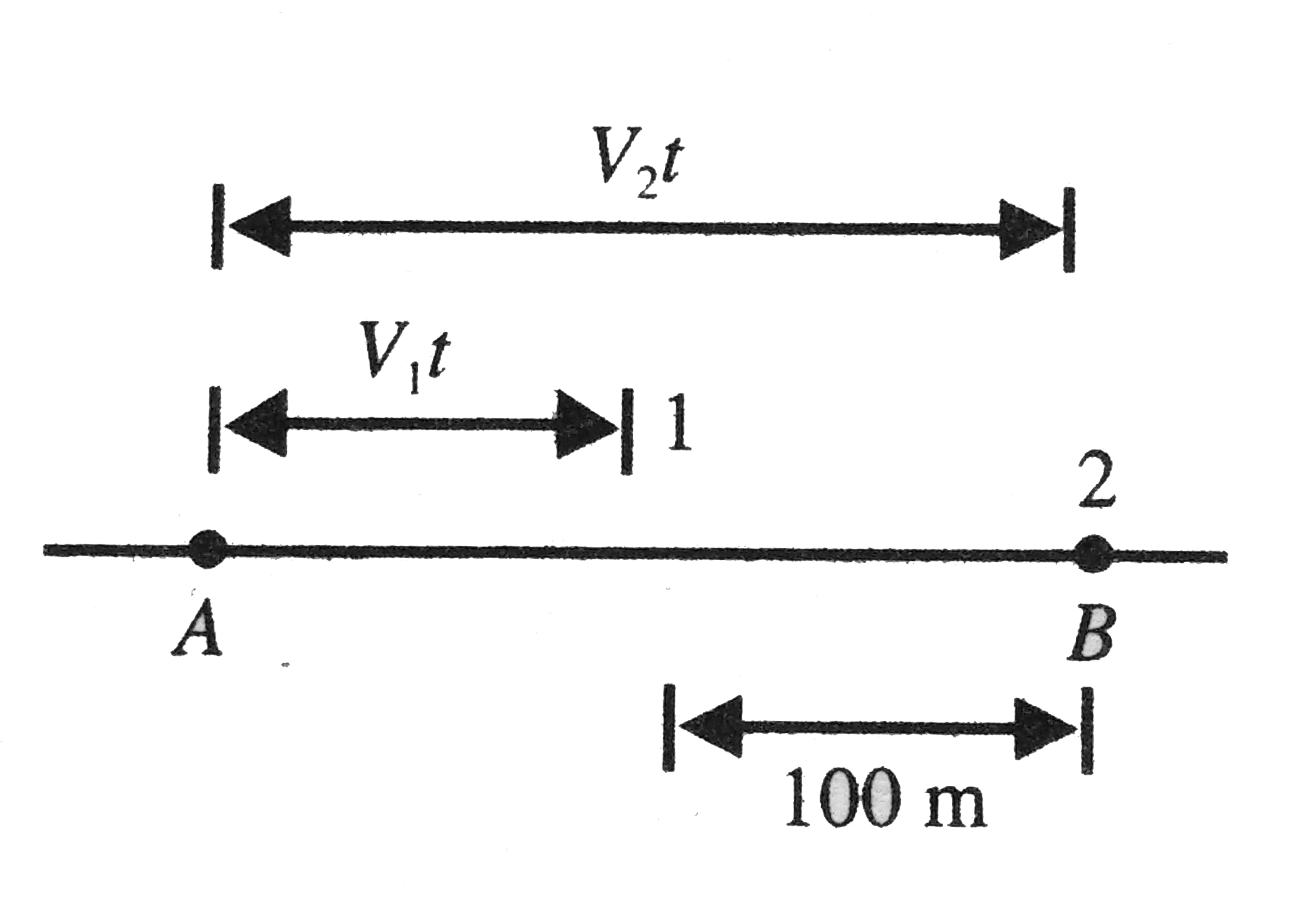In a car race sound signals emitted by two cars are detected by the detector on the straight track at the end point of the race. Frequency observer is 330 Hz and 360 Hz and the original frequency is 300 Hz of both cars. Race ends with the separation of 100 m between the cars. Assume both cars move with constant velocity and velocity of sound is 330ms. Find the time taken by wining car.

Let the velocity of car 1 and car 2 be V1 and V2, respectively.
Apparent frequencies of sound emitted by car 1 and car 2 as detected at end point are
f1=f0(V)V−V1,f2=f0(V)VV_2
330=300330330−V1,360=300330330−V2
V1=30ms and V2=55ms
The distance between both the cars just when the car 2 reaches end point B (as shown in fig) is
Topper's Solved these Questions
- SOUND WAVES AND DOPPLER EFFECTBook:CENGAGE PHYSICSChapter:SOUND WAVES AND DOPPLER EFFECTExercise:Single Correct
Explore 252 Videos
- SOUND WAVES AND DOPPLER EFFECTBook:CENGAGE PHYSICSChapter:SOUND WAVES AND DOPPLER EFFECTExercise:Multiple Correct
Explore 44 Videos
- SOUND WAVES AND DOPPLER EFFECTBook:CENGAGE PHYSICSChapter:SOUND WAVES AND DOPPLER EFFECTExercise:Exercise 6.2
Explore 72 Videos
- RIGID BODY DYNAMICS 2Book:CENGAGE PHYSICSChapter:RIGID BODY DYNAMICS 2Exercise:Interger
Explore 2 Videos
- SUPERPOSITION AND STANDING WAVESBook:CENGAGE PHYSICSChapter:SUPERPOSITION AND STANDING WAVESExercise:Comprehension Type
Explore 5 Videos
Similar Questions
(i) In a car race sound signals emitted by the two cars are detected by the detector on the straight track at the end point of the race. Frequency observed is 330 Hz and 360 Hz. The original frequency of horn is 300 Hz for both cars. Race ends with the separation of 1000 m between the cars. Assume both cars move with constant velocity and velocity of sound is 330 m/s. Find the time (in seconds) taken by the winning car to finish the race.
(ii) A source of sound of frequency f is dropped from rest from a height h above the ground. An observer O1 is located on the ground and another observer O2 is inside water at a depth d from the ground. Both O1 and O2 are vertically below the source. The velocity of sound in water is 4V and that in air is V. Find
(a) The frequency of the sound detected by O1 and O2 corresponding to the sound emitted the source initially.
(b) The frequency detected by both O1 and O2 corresponding to the sound emitted by the source at height h/2 from the ground.
View SolutionCar X and Car Y approaching each other. Frequency heard by car Y is 1320 Hz. Then, find actual frequency.

View Solution
Knowledge Check
Does he race cars?
AIs racing of the cars done by him?BAre cars raced by him?CDoes he the racing of cars?DAre race cars done by him?A policeman on duty detects a drop of 10% in the pitch of the horn of a moving car as it crosses him. If the velocity of sound is 330m/s, the speed of the car will be
A20m/secB17.3m/secC25m/secD27m/secA policeman on duty detects a drop of 10% in the pitch of the horn of a moving car as it crosses him. If the velocity of sound is 330m/s, the speed of the car will be
A17.4m/sB20.4m/sC18.7m/sD16.4m/s
The ratio of the apparent frequencies of a car when approaching and receding a stationary observer is 11:9 What is the speed of the car, if the velocity of sound in air is 330 m/s?
View SolutionA siren emiting sound of frequency 800Hz is going away from a static listence with a speed of 30m/sfrequency of sound to be beand by the listener is (velocity of sound=330m/s)
View SolutionThe frequency of a car horm is 400 Hz. If the horn is honked as the car moves with a speed uS=34ms through still air towards a stationary receiver, the wavelength of the sound passing the receiver is [velocity of sound is 340ms]
View SolutionA police car horn emits a sound at a frequency 240 Hz. When the car is at rest. If the speed of the sound is 330 m/s the frequency heard by an observer who is approching the car at a speed of 11 m/s is
View SolutionA car blowing a horn of frequency 350 Hz is moving normally towards a wall a speed of 5 m/s The beat frequency heard by a person standing between the car and wall is (speed of sound in air =350 m/s )
View Solution

